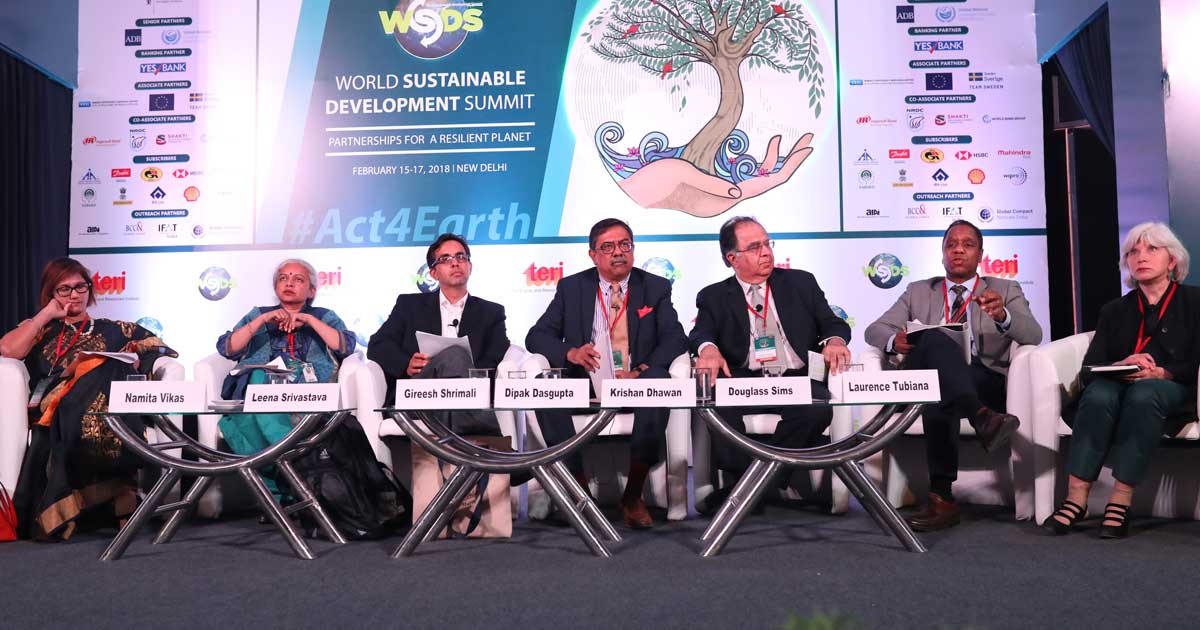
Innovative Financing Mechanisms Needed to fast track low-carbon development
 Funding the Future: Experts convene at the WSDS to deliberate upon innovative financing mechanism for low-carbon growth
Funding the Future: Experts convene at the WSDS to deliberate upon innovative financing mechanism for low-carbon growth
A group of salt pan farmers in the Rann of Kutch witnessed a humongous jump in their income, enhanced access to formal credit and found themselves free from the clutches of loan sharks—courtesy innovative green financing mechanisms.
About 48,000 salt pan farmers in the Rann of Kutch, including mostly women, had no access to formal credit. To make salt, they had to run diesel pumps and borrow from money lenders at steep rates of interest. Yes Bank introduced a cohort of 600 women to solar pumps for salt manufacturing. A local lending institution financed the solar pumps on the back of a credit enhancement given by Yes Bank. Following the intervention, the incomes of the salt farmers this year has grown from Rs 25,000 to Rs 75,000.
This was one of the examples of innovative financing mechanisms listed at the World Sustainable Development Summit 2018. Panelists convened for a session on ‘Innovative Financial Mechanisms: Raising the Trillions for Low Carbon Investments & Climate Resilience’.
Ms Namita Vikas, Group President & Global Head, Climate Strategy & Responsible Banking, Yes Bank, spoke about the rupee-denominated green bond issued by the International Finance Corporation in 2015, which was listed on the London Stock Exchange. The proceeds of the bond were invested by IFC in a green bond issued by Yes Bank to be further invested in the renewable energy projects.
She highlighted the risk-sharing mechanism and the ability of an AAA-rated development finance institution to raise mainstream capital from investors and then plough that back into the emerging countries. According to her, more participation from development financial institutions was needed to bring additional innovative financing mechanisms.
Dr Leena Srivastava, Vice Chancellor, TERI School of Advanced Studies, said there are new instruments for making finance available for renewable energy and there is reduction in the cost of greener technology at a pace that ensures that the need for finances may not be as large as anticipated. She added that the challenge, however, remains to assess whether they are actually reaching the bottom of the pyramid.
She said stakeholders need to ask themselves if they were doing enough for adaptation and resilience building. Dr Srivastava acknowledged there were a number of areas where capacity building needs to be done. She said more than the volume of the available finance, it was important to assess the manner in which it is deployed and the outcome it generates.
Mr Krishan Dhawan, CEO, Shakti Sustainable Energy Foundation, highlighted another financing aspect that is available in philanthropy. He said philanthropists are willing to invest patient capital in low-carbon initiatives.
The session was chaired by Mr Dipak Dasgupta, Distinguished Fellow, TERI & Former Principal Economic Adviser, Ministry of Finance, Government of India. Other panelists included Mr Douglass Sims, Director Of Strategy and Finance, Center For Market Innovation, NRDC; Dr Gireesh Shrimali, Director, Climate Policy Initiative, India; and Ms Laurence Tubiana, CEO, European Climate Foundation.